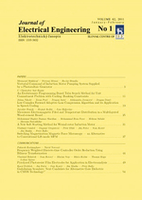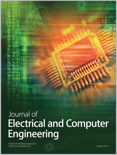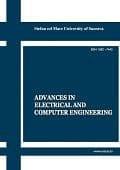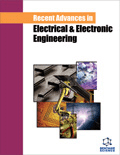
Journal of Electrical Engineering-Elektrotechnicky Casopis
Scope & Guideline
Exploring the Frontiers of Electrical and Electronic Solutions.
Introduction
Aims and Scopes
- Control Systems and Automation:
Research on control strategies, including PID controllers, adaptive control, and model predictive control, aimed at improving performance in various applications such as robotics, power systems, and industrial automation. - Signal Processing and Communications:
Studies focusing on signal processing techniques, communication protocols, and network systems, particularly in the context of wireless communications, IoT, and data transmission. - Power Electronics and Energy Systems:
Exploration of power converter designs, energy management systems, and renewable energy integration, emphasizing the optimization of electrical energy use and sustainability. - Sensors and Measurement Technologies:
Development and application of sensors for various measurement tasks, including temperature, pressure, and environmental monitoring, with a focus on enhancing accuracy and performance. - Nanotechnology and Advanced Materials:
Research on the application of nanomaterials in electrical engineering, including their use in sensors, energy devices, and electronic components, promoting innovative solutions for modern engineering challenges. - Machine Learning and Artificial Intelligence in Engineering:
Integration of machine learning and AI techniques in electrical engineering applications, ranging from predictive maintenance to intelligent control systems, enhancing operational efficiency and decision-making.
Trending and Emerging
- Smart Grids and Renewable Energy Integration:
There is a growing emphasis on research related to smart grids, energy management, and the integration of renewable energy sources, reflecting global trends towards sustainability and energy efficiency. - IoT and Sensor Networks:
Increased focus on Internet of Things (IoT) applications, including sensor networks and smart devices, showcases the journal's commitment to addressing modern connectivity challenges. - Artificial Intelligence and Machine Learning Applications:
The integration of AI and machine learning in various electrical engineering domains is trending, particularly in areas such as predictive maintenance, optimization, and intelligent systems. - Robotics and Automation Technologies:
Research in robotics, including control systems for robotic manipulators and automation in industrial settings, is gaining traction as industries seek to enhance efficiency and reduce labor costs. - Advanced Materials for Electrical Applications:
Emerging studies on nanomaterials and their applications in electrical engineering, particularly in sensors and energy devices, indicate a trend towards innovative material use in technology.
Declining or Waning
- Traditional Electromagnetics:
Research in classical electromagnetics, such as basic wave propagation and static field analysis, appears to be decreasing as newer technologies and applications emerge. - Analog Circuit Design:
There seems to be a waning interest in traditional analog circuit design topics, likely due to the increasing prevalence of digital solutions and integrated circuit technologies. - Basic Electrical Machine Theory:
Fundamental studies on electrical machines, while still important, are becoming less frequent as research trends lean towards advanced control strategies and smart grid technologies. - Conventional Power Systems Analysis:
Research focused on classical power systems analysis, such as load flow and short circuit studies, is declining as the field shifts towards smart grid and renewable energy integration. - Basic Communication Protocols:
The exploration of fundamental communication protocols is decreasing, as the field now emphasizes more complex systems and advanced networking technologies.
Similar Journals

Journal of Electrical and Computer Engineering
Exploring the Frontiers of Electrical and Computer EngineeringJournal of Electrical and Computer Engineering is a premier open-access journal published by HINDAWI LTD, dedicated to advancing the fields of electrical and computer engineering. With an ISSN of 2090-0147 and an E-ISSN of 2090-0155, this journal has been providing a platform for cutting-edge research since its inception in 2007. Based in the United States, it operates from its address at ADAM HOUSE, 3RD FLR, 1 FITZROY SQ, LONDON W1T 5HF, ENGLAND. The journal has established itself with a healthy impact factor, classified in the 2023 Q2 quartile for both Computer Science (Miscellaneous) and Electrical and Electronic Engineering, demonstrating its growing influence in the academic community. Additionally, its ranking positions it within the 67th percentile in General Computer Science and the 61st percentile in Electrical and Electronic Engineering on Scopus, indicating its significant contribution to these fields. Covering an extensive scope from 2010 to 2024, the journal seeks to publish innovative research articles, reviews, and case studies that explore new techniques and applications in electrical and computer engineering, benefiting a wide audience of researchers, professionals, and students focused on these rapidly-evolving areas.

Advances in Electrical and Computer Engineering
Elevating Standards in Innovative Engineering SolutionsAdvances in Electrical and Computer Engineering is a leading open-access journal published by the University of Suceava, Faculty of Electrical Engineering, since 2007, promoting the dissemination of innovative research in the fields of electrical engineering and computer science. With an ISSN of 1582-7445 and an E-ISSN of 1844-7600, the journal serves as a vital resource for researchers, professionals, and students, contributing to the growth of knowledge and technology in these critical areas. The journal holds a respectable Q3 ranking in both Computer Science and Electrical and Electronic Engineering, reflecting its commitment to quality and relevance in high-impact research. Recognized in Scopus, it ranks #154 out of 232 in General Computer Science and #528 out of 797 in Electrical and Electronic Engineering, indicating its solid standing in the academic community. By providing open access to invaluable research findings, Advances in Electrical and Computer Engineering plays a pivotal role in advancing the frontiers of technology and engineering.

Jordan Journal of Electrical Engineering
Elevating Standards in Energy Engineering and TechnologyJordan Journal of Electrical Engineering, published by TAFILA TECHNICAL UNIVERSITY (TTU) in Jordan, serves as a critical platform for disseminating groundbreaking research in the fields of electrical engineering, energy systems, and related disciplines. With an ISSN of 2409-9600 and an E-ISSN of 2409-9619, the journal is committed to promoting advancements in energy engineering, biomedical applications, control systems, and signal processing among others. Despite its recent establishment in 2023, it has been indexed in multiple categories within Scopus, receiving rankings that reflect its emerging role in the academic community. Researchers and professionals are encouraged to contribute and access cutting-edge articles through open access options, ensuring that knowledge is readily available to all interested parties. As the journal continues to grow, it aims to bridge gaps in knowledge and stimulate dialogue, thereby supporting innovation and practical applications in the engineering sector.

Electrical Control and Communication Engineering
Exploring the frontiers of electrical control and communication.Electrical Control and Communication Engineering is a premier Open Access journal dedicated to the vibrant fields of electrical engineering, control systems, and communication technologies. Published by SCIENDO, this journal not only aims to disseminate significant research findings since its inception in 2012 but also fosters a collaborative platform for researchers, professionals, and students from around the globe. With its commitment to high standards and rigorous peer review, the journal seeks to advance the collective understanding of innovative technologies and methodologies in electrical control and communication systems. With an ISSN of 2255-9140 and an E-ISSN of 2255-9159, the journal is gaining visibility and impact within the academic community, encouraging open and accessible scholarship to drive progress in this critical sector. Housed in Warsaw, Poland, it is poised to be an invaluable resource for those engaged in cutting-edge research and applications in electrical and communications engineering.

Electronics
Unveiling Insights in Electronics and CommunicationElectronics, published by MDPI since 2012, stands as a pivotal open-access journal that caters to a wide spectrum of disciplines within the electrical and electronic engineering domain. With a strong commitment to disseminating innovative research, this journal has garnered notable recognition, achieving a Q2 ranking in multiple pertinent categories, including Computer Networks and Communications, Control and Systems Engineering, and Signal Processing. Its editorial standards and open-access format enhance the visibility and accessibility of high-quality research, making critical advancements in technology available to a global audience. Located in Switzerland, the journal is positioned to foster international collaboration and dialogue among researchers, professionals, and students dedicated to exploring the evolving landscape of electronics and its applications. With an E-ISSN of 2079-9292, the journal is meticulously indexed in reputable databases like Scopus, further solidifying its relevance and influence in the engineering community.

Elektronika Ir Elektrotechnika
Unlocking Potential in Engineering through Open AccessElektronika Ir Elektrotechnika is a premier academic journal dedicated to the field of electrical and electronic engineering, published by Kaunas University of Technology, Lithuania. With an Open Access model since 2004, this journal ensures that cutting-edge research is accessible to a global audience, facilitating the dissemination of knowledge and fostering innovation in the engineering community. The journal is currently categorized in the Q3 quartile for Electrical and Electronic Engineering as of 2023 and holds a Scopus ranking of #473 out of 797, placing it in the 40th percentile. Covering a diverse range of topics from emerging technologies to foundational research, Elektronika Ir Elektrotechnika serves as an invaluable resource for researchers, professionals, and students alike, supporting the advancement of both theoretical and practical aspects in electrical engineering. As we converge towards the years 2008 to 2024, the journal invites submissions that contribute to the evolving landscape of the discipline, aiming to inspire future innovations and collaborations.

Journal of Electrical Engineering & Technology
Illuminating the Path of Electrical Engineering ResearchJournal of Electrical Engineering & Technology is a prominent academic journal published by SPRINGER SINGAPORE PTE LTD, dedicated to advancing the field of Electrical and Electronic Engineering. With an established history since 2008, the journal has become a vital resource for professionals, researchers, and students seeking to explore innovative research and technological developments within the discipline. The journal boasts a commendable 2023 Scopus Rank of #334 out of 797 in its category, reflecting its quality and the impact of published works. As a Q2 category journal, it upholds rigorous peer-review standards, making it a credible platform for disseminating groundbreaking findings. While currently not an open-access publication, the journal ensures that its content is accessible to a global audience committed to knowledge enhancement and technological progress. Subscribe or access issues through institutional affiliations to stay at the forefront of advancements in electrical engineering.

Journal of Control Automation and Electrical Systems
Connecting Theory and Practice in Electrical EngineeringThe Journal of Control Automation and Electrical Systems, published by SPRINGER, is a prominent academic journal dedicated to advancing research in the interdisciplinary fields of control systems, automation, and electrical engineering. With an ISSN of 2195-3880 and E-ISSN of 2195-3899, this journal has emerged as a vital platform for disseminating high-quality research, contributing significantly to both theoretical and applied aspects of these interrelated domains. As of 2023, it ranks in the Q2 and Q3 quartiles across multiple categories, including Electrical and Electronic Engineering and Energy Engineering, showcasing its relevance and impact in the field. Although not an open-access journal, it provides rich access options for research works, ensuring that findings reach a wide audience. Researchers, professionals, and students alike can draw valuable insights from its curated articles that explore emerging trends, innovative technologies, and practical applications, thus reinforcing its position as a key contributor to the advancement of control and automation systems.

Recent Advances in Electrical & Electronic Engineering
Connecting Knowledge with Engineering SolutionsRecent Advances in Electrical & Electronic Engineering is a prominent scholarly journal dedicated to publishing cutting-edge research and developments in the fields of electrical and electronic engineering. Published by BENTHAM SCIENCE PUBL LTD, this journal aims to disseminate significant findings that advance knowledge and technology across various disciplines related to electrical and electronic engineering. With an ISSN of 2352-0965 and an E-ISSN of 2352-0973, the journal is accessible to a global audience, facilitating open scholarly discourse. Although it currently holds a Q4 ranking in both electrical and electronic engineering and materials science categories, it contributes to ongoing dialogues critical for advancing innovations within these sectors. Notably, the journal’s convergence years span from 2007 to 2024, securing its continual relevance in an evolving academic landscape. With a commitment to high-quality research, this journal serves as an essential resource for researchers, professionals, and students seeking to stay abreast of advancements and emerging challenges within the realm of electrical and electronic engineering.

IEEE Open Journal of Industry Applications
Unlocking the future of industrial engineering through collaboration.IEEE Open Journal of Industry Applications is a premier open-access publication established in 2020 by the esteemed IEEE-INST ELECTRICAL ELECTRONICS ENGINEERS INC, dedicated to advancing the fields of Control and Systems Engineering, Electrical and Electronic Engineering, and Industrial and Manufacturing Engineering. With a strong commitment to disseminating high-quality research, the journal has rapidly garnered recognition, achieving a Q1 quartile ranking in multiple engineering categories, notably securing a rank of 21st out of 321 in Control and Systems Engineering and 26th out of 384 in Industrial and Manufacturing Engineering as of 2023. This journal not only facilitates immediate access to cutting-edge findings but also fosters an inclusive academic environment where researchers, professionals, and students can engage with and contribute to the evolving landscape of industry applications. By embracing open access, it ensures that pivotal research is freely available, thereby maximizing its impact on the scientific community. For potential contributors and readers, the journal's robust Scopus rankings—placing it in the top 7% of its fields—highlight its significance as a leading platform for innovative discussions and explorations in engineering.